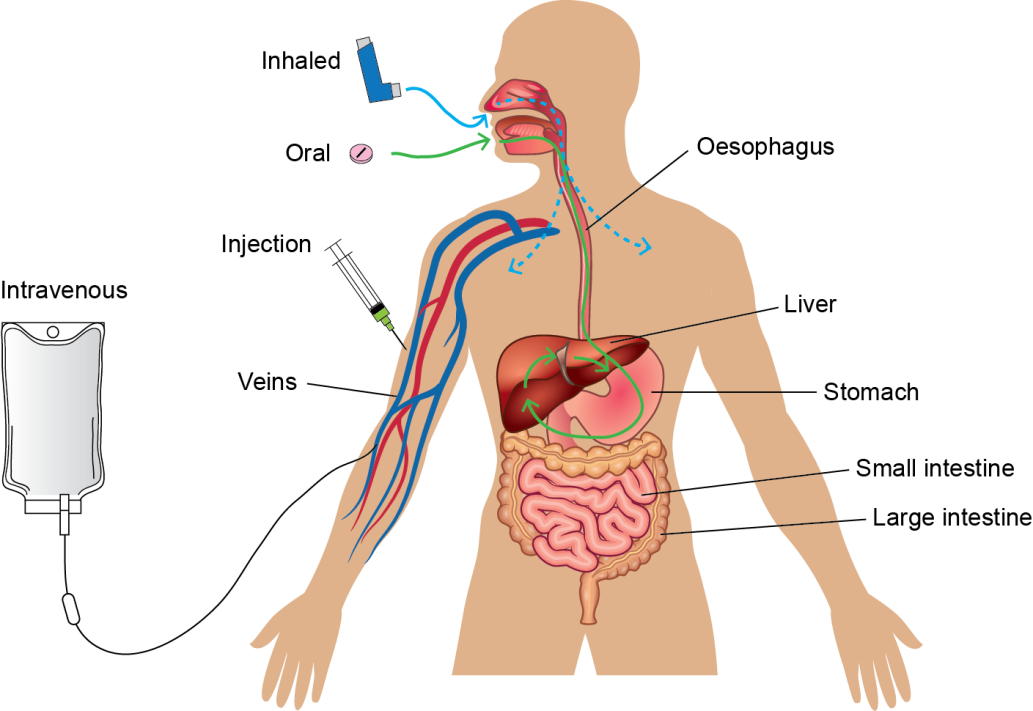How medicines are administered
How medicines are administered
The first step in using a medicine is to deliver it into the body. Medicines can be administered using a variety of methods (Figure 1.2). Some are packed into tablets and others are given through injections, or as creams, sprays or drops. The method used will depend on the characteristics of the active substance
and the patient characteristics (for instance someone unconscious cannot swallow a tablet). Most medicines have to be dissolved in water so that they can be absorbed in the body. Active substance
molecules also need to be able to pass through the body’s membranes (thin layers of tissue
), such as those that line the stomach or blood vessels, in order to be absorbed into the bloodstream. These membranes consist of a fatty layer and, because fats and water do not mix well, active substances also ideally need to be soluble
in fats. It is therefore important to strike a balance between water and fat solubility
. Chemists can alter the structure of the molecules to improve their ability to pass through membranes.
Figure 1.2. Medicines can be administered using injections,
tablets, creams, sprays or drops. Oral medicines pass through the stomach,
intestine and liver before entering the bloodstream. Most injections, sprays and
drops bypass the digestive system and liver, but need to cross cell membranes
to reach the blood. Intravenous injections
are delivered straight into the blood through a vein.
Many medicines are taken as tablets. However, there are a number of challenges. Firstly, the tablet has to be small and soluble in water to be absorbed. Once the active substance reaches the stomach, the gastric acids will attempt to break it down, in the same way they break down food. The active substances therefore need to be able to pass through the stomach intact. Protein-like active substances, such as insulin, are easily broken down by the stomach and, therefore, cannot be taken as tablets, whereas substances that do not lose their function after being exposed to stomach acids and which are small enough to pass through the stomach lining can be administered this way. After being absorbed through the lining of the stomach or intestine, orally taken active substances are carried in the blood to the liver. This presents another challenge, because in the liver, proteins called enzymes also break down the active substances into smaller parts, known as metabolites. This is called the ‘first pass effect’. Some oral medicines are designed to take advantage of this process, and the metabolites are more active than the original molecule. Some other active substances are deactivated in the liver, and large quantities can be lost in this way. The degree to which the first pass effect influences medicines varies according to the type of chemical the active substance is made from and the dose given.
Active substances that are readily broken down in the stomach or liver are given by injection, as are substances made of large, complex molecules (see the section on biologics). Medicines can be injected into the muscle (intramuscular), under the skin (subcutaneous), or directly into a vein (intravenous). The first two methods require the active substance to be soluble, so that it can pass through the body’s membranes into the bloodstream. Injecting a medicine into the vein bypasses this requirement and the active substances are immediately available for distribution through the bloodstream to their target tissue. This method is often used for large, complex molecules that are insoluble or too big to pass through membranes. It is also used for active substances that do not mix well enough with fat to pass through the membranes of the stomach, intestine and blood vessels linings.
Once in the bloodstream, the active substance is distributed around the body and should find its way to the organs and cells where it is needed. However, it will also come into contact with other organs which can result in side effects. It is important for doctors and patients to be aware of side effects that may occur and how best to monitor and treat them.
Medicinal products can be modified to minimise these side effects. For example, acetylsalicylic acid irritates the stomach lining. However, it can be coated with molecules that do not break down in the acidic environment of the stomach and thus protect the stomach. Once the tablet passes into the less acidic intestine the barrier coating breaks down, releasing the active substance, which is then absorbed into the body.
The final stage is the breakdown by the liver. The active substances are carried by the blood to the liver (for oral medicines, this will be the second time that they have entered the liver). There, they are eventually broken down into molecules that can be removed from the body. Most water-soluble active substances are excreted through urine; others are excreted in faeces. When designing medicines, scientists need to consider how the molecules will be excreted. For example, those that are excreted in the urine may not be suitable for patients with poor kidney function.